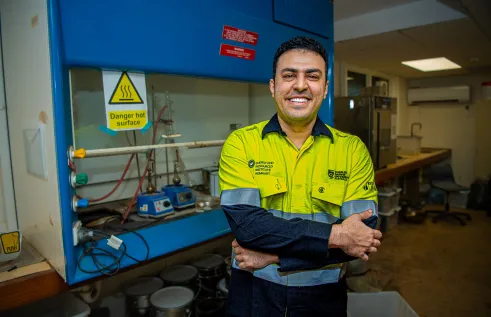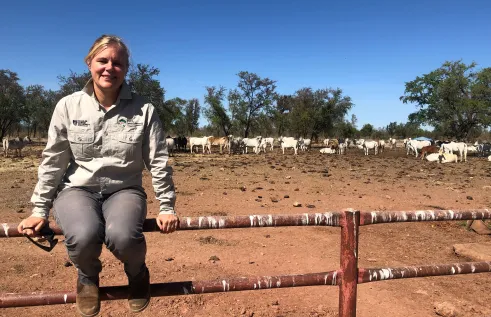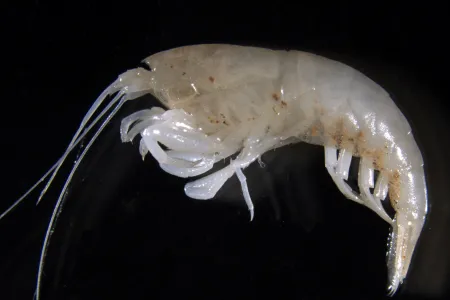News Article
Scientists’ outback fishing trip discovers exotic catch
Research scientists from Australia’s national science agency, CSIRO and Charles Darwin University used fishing rods and handlines to plumb the depths of underground aquifers in the Northern Territory revealing a diverse variety of tiny aquatic animals known as stygofauna, mostly between 0.3 and 10 millimetres in length.
The largest animal found – a shrimp called Parisia unguis – measured up to 20 millimetres and is likely the apex predator in these communities. The presence of a predator indicates a complex food chain within the Beetaloo stygofaunal communities.
The Beetaloo animals are different from stygofauna recorded from more extensively studied Western Australian aquifers, with new genera and species of crustaceans likely to be present in the Beetaloo.
Results confirm Northern Territory aquifers support a diverse range of stygofaunal species. All Beetaloo stygofaunal communities sampled were dominated by crustaceans - shrimps, amphipods, ostracods, copepods and syncarids.
CSIRO scientist Dr Gavin Rees said the presence of the same stygofaunal species at widely separated sites across the Cambrian Limestone Aquifer could indicate high connectivity within the aquifer which would need to be considered in light of shale gas development proposals.
“CSIRO’s Gas Industry Social and Environmental Research Alliance is undertaking further research to quantify the risk of contamination impacts on stygofauna from possible industrial spill events,” Dr Rees said. “This research takes into account migration pathways and processes, including adsorption, dilution and microbial metabolism in soils and aquifers as well as the suspected high connectivity in groundwater systems.”
CDU Professor Jenny Davis said stygofauna were the ultimate climate change adapters, having moved underground as surface waters of ancient inland Australia dried out. “It’s incredibly exciting because some of these crustaceans are new to science – there are not many places left in the world where you can find a whole range of new animals in one location,” Professor Davis said.
Researchers from CSIRO and the university’s Research Institute for Environment and Livelihoods collected samples from 26 groundwater bores and two springs in August and October 2019, across a distance of approximately 500 km, from the sub-tropical Mataranka region in the north to the semi-arid Barkly Tablelands (Barkly Stock Route) in the south.
In addition to fishing rods and nets, researchers also used water pumps and cutting-edge eDNA analysis to detect the presence of known and unknown stygofauna in groundwater samples.
The collaborative pilot project was funded through CSIRO’s GISERA and addressed knowledge gaps about stygofauna in line with the Final Report of the Scientific Inquiry into Hydraulic Fracturing in the Northern Territory.
The stygofauna sampling program is part of a suite of CSIRO’s GISERA research projects either completed or in progress in the Northern Territory, in line with Scientific Inquiry recommendations. Baseline studies of methane and groundwater characteristics are complete.
New CSIRO GISERA projects in progress include microbial degradation of shale gas-related chemicals, minimising potential emissions from gas wells through improved leak sealing technologies and well-decommissioning practices, development of high-quality spatial data to guide land management practices, and assessment of options to offset life-cycle greenhouse gas emissions.
Results of these studies are important for informing appropriate policy and management responses to shale gas development proposals.
Read the report here.
Charles Darwin University is actively seeking Higher Degree by Research students to take part in research projects like this. Scholarships are available. Learn more here.
Related Articles

Where rubber meets the road: Old tyres are key to building tougher roads
Almost half of the Northern Territory’s worn-out tyres end up in landfills – with the rest exported interstate for recycling – but a study led by Charles Darwin University (CDU) is repurposing the discarded rubber to build stronger, sustainable roads that meet the NT’s unique needs.
Read more about Where rubber meets the road: Old tyres are key to building tougher roads
Social media subjecting Black women to radicalised digital policing
Influencers use oppression, manipulation and weaponisation to police Black women on social media, according to new research uncovering the entrenched nature of digital racism.
Read more about Social media subjecting Black women to radicalised digital policing
Moo-ving the boundaries: New research evaluates virtual fences for use on NT cattle stations
Cattle producers in Northern Australia face unique challenges when adapting tools like virtual fences on their properties, but new research from Charles Darwin University (CDU) is set to break down the barriers to this technology.
Read more about Moo-ving the boundaries: New research evaluates virtual fences for use on NT cattle stations
